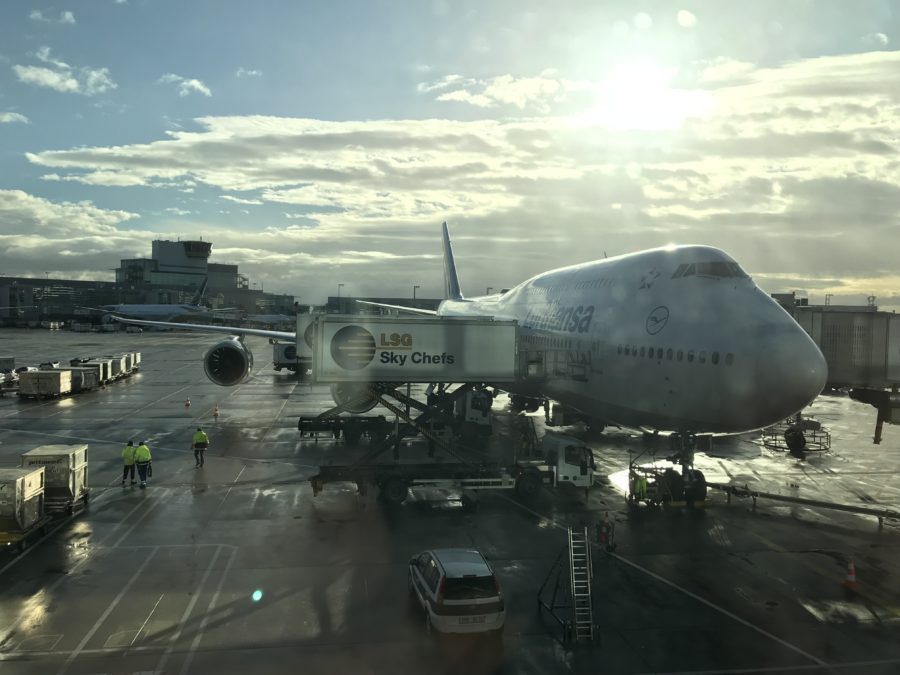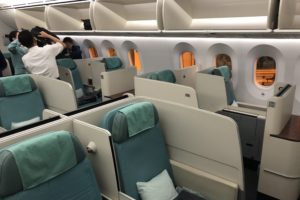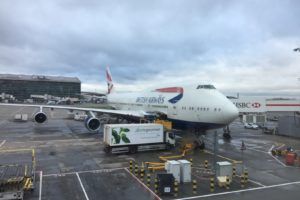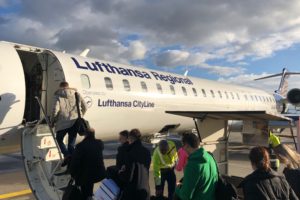How To Fly On The Queen Of The Skies – The Boeing 747
The Boeing 747 is perhaps the most iconic aircraft ever created. It debuted in 1970 with Pan Am, and since them over 1,500 of them have been created, though only up to 500 are still flying today. It is iconic for its partial upper deck, which originally was intended to be a lounge for first-class passengers, although serves as additional seating for (mostly) business class. The 747 was the first superjumbo and was the first wide-body jetliner, and was for decades the premier aircraft for long-haul flights. A total of six passenger variants with multiple sub-varients of the 747 have been created, most recently being the Boeing 747-8, which debuted in 2011. Unfortunately, the 747-8 has not been doing so well in terms of sales, and only about 130 of them have been made, with only a few more cargo aircraft still outstanding to UPS.
All major commercial US airlines have retired their 747s, as United and Delta both retired their 747-400s in late 2017. Unfortunately, the 747s are becoming more and rarer as it is just not economical for airlines to operate four-engined aircraft with too much capacity instead of efficient newer aircraft such as the A350 and 787 which have two engines. Essentially, the 747 has had a long life, but the newest variant is suffering the same problems as the A380 – having too much capacity with too many engines. However, the 747 is one of the smoothest planes in the sky and is very comfortable for passengers. The 747 will be nearly gone in commercial service within 10 years, and I wouldn’t be surprised if the three commercial operators of the 747-8 would bring their lives to an end sooner just because of the high fuel costs. In this article, I’ll explain which routes the 747 operates and on which airlines and some of the ways to fly them.
British Airways

British Airways is the largest commercial operator of the Boeing 747. They currently have 34 Boeing 747-400s in their fleet, although their fleet used to be much larger just a few years ago with 56 747-400s in their fleet! They opted not to order the 747-8 despite their large number of 747s already in their fleet. British Airways is planning on retiring all of their Boeing 747-400s by 2024, meaning that you still can fly on a British Airways 747 for five more years. Their cabins are pretty outdated, although they still have flatbed seats in business class (although it’s in a 2-4-2 configuration and is one of the worst business class seats), a cramped first class product (also not industry leading) and personal on-demand at all seats. They also recently repainted three of their 747s in BOAC, Landor, and Negus retro liveries as part of their 100th anniversary. British Airways will replace their Boeing 747s with Airbus A350-1000s and Boeing 777-9Xs. Their 747s can be spotted on a ton of routes, given that they operate 34 of them, including from London Heathrow to:
- Austin Bergstrom International Airport (I know, I was just as surprised as you)
- Chicago O’hare International Airport
- Denver International Airport
- Las Vegas McCarren International Airport
- Los Angeles International Airport (1-2x Daily)
- Miami International Airport (3x Daily)
- New York JFK International Airport (5-6x Daily)
- Philidelphia International Airport
- Phoenix Sky Harbor International Airport
- San Francisco International Airport
- Seattle Tacoma International Airport
- Washington Dulles International Airport (2x Daily)
- Accra Kotoka International Airport
- Nairobi International Airport
- Lagos Murtala International Airport
- Cape Town International Airport
- Johannesburg OR Tambo International Airport
Lufthansa

Lufthansa is a close second in terms of the number of 747s which they operate, with now a total of 32 747s. They operate 13 Boeing 747-400s and 19 Boeing 747-8s. They were the commercial launch customer of the Boeing 747-8 in 2012, and are by far the largest commercial operator of the latest variant. Their 747-400s are in a three-class configuration with economy, premium economy and business class while their 747-8s also have first class, located in the iconic nose of the 747. Business class has flatbed seats in a 2-2-2, 2-3-2, or 2-2 configuration while first class has open suites in a 1-2-1 and 1-1 configuration. Lufthansa plans on retiring their 747-400s by 2025. However, their 747-8s are relatively new and should have a lifespan of about 20-25 years in commercial service. However, Lufthansa indicated that they might retire them earlier than that due to high fuel and operating costs. Overall, you should be able to see Lufthansa 747s in service for the next 10 years at the very least. Lufthansa will replace their 747s with Boeing 777-9Xs. Lufthansa also has one 747-8 in a retro livery. Their 747-400s can be spotted flying from Frankfurt to:
- Denver International Airport
- Orlando International Airport
- Philidelphia International Airport
- Seattle Tacoma International Airport
- Rio de Jianero Galeao International Airport
- Toronto Pearson International Airport
- Vancouver International Airport
- Shanghai Pudong International Airport
- Mumbai Chhatrapati Shivaji International Airport
- Seoul Incheon International Airport
Their 747-8s can be spotted from flying from Frankfurt to:
- Boston Logan International Airport
- Chicago O’Hare International Airport (2x Daily)
- Los Angeles International Airport (2x Daily)
- New York JFK International Airport
- Newark Liberty International Airport
- Washington Dulles International Airport
- Buenos Aires Ministro Pistarini International Airport
- Sao Paulo Guarulhos International Airport
- Beijing Capital International Airport
- Bengaluru Kempegodwa International Airport
- Tokyo Haneda International Airport
- Mexico City International Airport
Johanessburg OR Tambo International Airport
KLM

KLM is unique in its fleet of Boeing 747s as it is the only operator of the Boeing 747-400M. You may be asking yourself, what is the 747-400M? It is more commonly known as the Boeing 747 Combi, as it operates with a dual configuration with both passengers and cargo. It has significantly less passenger space (it only holds 268 passengers) and has the rest of the fuselage space being a cargo hold. Back in the day, KLM ordered only 5 regular Boeing 747-400s but ordered 15 Boeing 747 combis. However, currently, they only have 3 regular 747-400s and 7 Boeing 747-400 Combis, with plans to retire them all by 2021. KLM operates its 747s in a two-class configuration, with flat-bed seats in business class and personal on-demand entertainment by all seats. KLM will replace its 747s with both Airbus A350-900s and Boeing 787-10s. KLM currently flies their 747s from Amsterdam Schiphol to:
- Chicago O’Hare International Airport (sporadically)
- Los Angeles International Airport (sporadically)
- New York JFK International Airport (sporadically)
- San Francisco International Airport
- Toronto Pearson International Airport
- Willemstad Curacao Hato International Airport
- Nairobi Jomo Kenyatta International Airport
- Mexico City International Airport
- Seoul Incheon International Airport (sporadically)
- Paramaribo Zanderij International Airport
Korean Air

Korean Air technically still operates both the Boeing 747-400 and the Boeing 747-8. However, they only operate two 747-400s and use them on only a couple short-haul routes (such as from Seoul to Manila and Bangkok) and I think that they are close to fully retiring the aircraft type. However, they operate ten Boeing 747-8s, making them the second largest commercial operator of that aircraft type. Their 747-8s are in a three-class configuration and have closed suites in first class and Apex suites in business class (you can read a review of their 787 business class which have the same seats here). Korean Air used to operate many more 747-400s, although they have since replaced most of them with Boeing 747-8s, Airbus A380s, and Boeing 777-300ERs. They currently have no plans to replace their 747-8s, which makes sense, given that most of them are less than five years old. Korean Air rotates the schedules of their 747s throughout the year, although they currently fly thee Boeing 747-8s from Seoul Incheon to:
- Atlanta Hartsfield-Jackson International Airport
- Honolulu International Airport
- Frankfurt International Airport
- Rome Leonardo da Vinci International Airport
- London Heathrow Airport
Virgin Atlantic

Virgin Atlantic actually doesn’t operate its 747s out of London-Heathrow anymore – it operates its 747-400s solely out of London-Gatwick and Manchester. Virgin Atlantic currently only operates 8 Boeing 747-400s, a fraction of the number that they used to operate. Virgin Atlantic operates them in a high-density configuration, meaning that there are only 14 business class seats while the rest of the plane is premium economy and economy class. This makes sense as they operate the aircraft to leisure destinations out of London’s leisure airport (Gatwick), Manchester, Belfast, and Glasgow. That means that they can squeeze 455 passengers onto their 747s! Unfortunately, Virgin Atlantic plans to retire all of their 747s by the year 2021 and will replace them with Airbus A350-1000s, which have a far superior interior product. Virgin Atlantic operates its 747s from:
- London Gatwick to Bridgetown Grantley Adams International Airport (sporadically)
- London Gatwick to Montego Bay Sangster International Airport
- London Gatwick to Orlando International Airport (2x Daily)
- Manchester to Atlanta Hartsfield Jackson International Airport
- Manchester to New York JFK International Airport
- Manchester to Orlando International Airport (1-2x Daily)
- Belfast to Orlando International Airport (seasonally)
- Glasgow to Orlando International Airport (seasonally)
Air China

Air China also technically still operates both the Boeing 747-400 and the Boeing 747-8, although it doesn’t operate the 747-400 much anymore. One is used as a VIP transport (think Air Force One of China) and two others operate on some domestic routes within China mostly from Beijing to Shenzhen. Air China also operates seven 747-8s, although one is also used as a VIP transport. Air China’s 747-8s have flatbed seats in business class (2-2-2 or 2-2 configuration) and have closed suites in first class. Air China hasn’t given any retirement plans for the 747-400, although I’d imagine that since they only are using two at the moment, that they’ll retire them either in 2019 or 2020, although that is speculation. Their 747-8s they will rightfully keep in their fleet as their flagship aircraft for years to come. They currently fly their 747-8s from Beijing to:
- New York JFK International Airport
- San Francisco International Airport
- Shanghai Hongqiao Airport
- Guangzhou Baiyun International Airport
- Frankfurt International Airport (sporadically)
Qantas

Up until just a few years ago, the 747 flew the vast majority of Qantas’ long-haul and North American routes. However, they recently just announced that they’d be ending their last North American 747 route on December 4, 2019, from Sydney to San Francisco. They currently have 8 Boeing 747-400s in their fleet. Qantas also is unique in that they were the only customer of the Boeing 747-400ER, which is an extended range of the Boeing 747-400, and currently, six out of the eight 747s in their fleet are the ER variant. Onboard, Qantas has flatbed seats in business class in a 2-3-2 or 2-2 configuration and have personal on-demand entertainment in economy, premium economy, and business. Qantas has phased out most of their 747s and will continue to do so until they retire their last Queen of the Skies by the end of 2020. They have replaced them with much more fuel efficient 787s and with the Airbus A380. They currently fly their 747s from Sydney to:
- Honolulu International Airport
- San Francisco International Airport
- Santiago International Airport
- Tokyo Haneda International Airport
- Johanessburg OR Tambo International Airport
Thai Airways

Thai Airways has a total of nine Boeing 747-400s and has plans to keep them in service until 2022. However, that’s a small portion of the 18 that they used to have at the beginning of the decade. Thai Airways uses their 747s mostly on short-medium intra-Asia haul routes, although they also use the aircraft on their daily flight from Bangkok to Sydney. Thai Airways has a fairly dated configuration in business class with angle flat seats in a 2-2 configuration. However, Thai recently retrofitted their 747 first class to include closed suites in a 1-1 configuration. In addition, personal on-demand entertainment is available at all seats on all of their 747s. Thai phased out half of their 747s and replaced them with 777s and A380s, although Thai has yet to come up with a replacement aircraft for their 9 747s still in their fleet. Thai currently flies their Boeing 747-400s from Bangkok to:
- Sydney Kingsford Smith Airport
- Delhi Indira Gandhi International Airport
- Mumbai Chhatrapati Shivaji International Airport
- Denpasar Ngurah Rai International Airport
- Kuala Lumpur International Airport
- Seoul Incheon International Airport
- Tokyo Haneda International Airport (2x Daily)
- Phuket International Airport (3x daily – I find it cool that they fly a 747 on a
1 hour domestic flight)
Other Airlines
There are multiple other Boeing 747 operators, although none of them operate a substantial 747 fleet or operate on many long-haul flights. For example, Asiana Airlines operates two Boeing 747-400s and China Airlines operates 4 747s, which they both use solely on short haul flights. Similarly, Air India, where they operate 4 747-400s, but only within India and to Saudi Arabia. Israel’s El Al also operates four Boeing 747-400s which they do use on some of their New York flights, but I decided not to make a whole new section for them because they will retire them by the end of 2019. Saudia also operates nine 747s, but they only use them on short-haul flights. Additionally, Rossiya, a subsidiary of Aeroflot, uses their ex-Transaero 747-400s on long-haul intra-Russian flights and on some of their flights to Thailand. Additionally, Tui subsidiary Corsair uses their three 747s on some of their flights to Mauritius. Iraqi Airways also operates two 747-400s on short-haul flights. Finally, Wamos Air, a charter airline, operates their 747s on commercial service from Madrid to Cancun and Punta Cana but also wet-leases out their 747s to other airlines occasionally. Besides that, no other airlines have scheduled commercial service using Boeing 747s.
Conclusion
Four-engined aircraft are coming to an end. I wrote a post earlier about how even a modern four-engined aircraft, the A380 is proving to be uneconomical. The 747-400, an older variant is simply getting too old for airlines to economically maintain, and the 747-8 simply never was a success for commercial airlines and most likely will be phased out prematurely. The 747 will remain in service probably for at least 10 years, although each year, they will become increasingly rare as airlines decide to retire them. The Queen of the Skies will always be remembered as the first superjumbo and widebody jet and played an influential role in the development of long-haul and jet aircraft. Unfortunately, her days are numbered, and the days of flying on the 747 are getting more and more limited.
What is your favorite experience flying on a Boeing 747?




